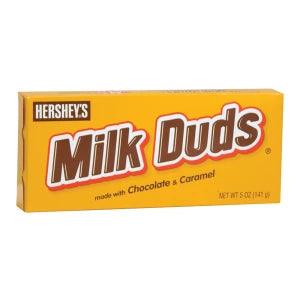
Everything You Need to Know About Milk Duds
Milk Duds—a name that conjures images of movie theater concessions and childhood nostalgia. This delightful caramel candy, cloaked in a smooth chocolate shell, has endured as an American favorite for nearly a century. But what exactly are Milk Duds, and what has contributed to their enduring popularity?
In this comprehensive guide, we'll delve into the history, ingredients, marketing strategies, and consumer trends surrounding Milk Duds, with an exploration of their unique competitive landscape.
The History of Milk Duds
Historical Introduction to Milk Duds
To understand Milk Duds, we must first journey back to their origins. Created by F. Hoffman & Company of Chicago in 1928, Milk Duds have carried a whimsical charm through an era defined by economic depression and rising consumer culture. Advertised as a neat little treat, their name—"Milk Duds"—was coined from their less-than-perfect round shape, a playful nod to their irregular forms which were "duds" in their creator's eyes.
Key Historical Events and Influences
Milk Duds found their fame in part due to strategic marketing and popular cultural trends. During the Great Depression, they became a delightful yet affordable indulgence for many Americans, with strong associations with movie theaters providing an escape for thrifty patrons. The 1970s saw Milk Duds partnering with baseball, leveraging the all-American pastime to further cement their place in the candy market.
The Delightful Composition of Milk Duds
Ingredients: A Sweet Symphony
A simple blend of caramel, chocolate, and nonfat milk forms the foundation of a Milk Dud. Initially cooked with cocoa butter, today's Milk Duds employ vegetable oils—a change that has sparked much debate among confectionery purists. What truly sets them apart is their distinct chewy caramel core, paired with just the right amount of chocolate coating.
Manufacturing Process
Hershey’s—which produces Milk Duds under license from Highlander Partners—operates a sophisticated manufacturing process responsible for the candy’s signature texture and taste. From the careful heating of caramel to the precise enrober techniques that wrap each candy in chocolate, creating Milk Duds is a true confectionery art form.
Marketing and Sales Strategies
Cinema Spotlight: Brand Association Masterstroke
Milk Duds have long been a cherished choice at theaters, a strategic partnership solidified over decades. Their durability and poppable nature make them an ideal cinema snack, aligning perfectly with the experience of movie-watching. This relationship has been pivotal in sustaining Milk Duds' popularity over the years.
Past Promotion Strategies
Historically, marketing for Milk Duds has played on their nostalgic value and "imperfect" perfection. Promotions have, at times, featured iconic American sports figures, particularly baseball players in the 1970s, further embedding them in the national consciousness.
Consumer Preferences and Trends
Nostalgia as a Driving Force
Many consumers associate Milk Duds with fond memories, a treat they enjoyed in their youth or at the movies. This nostalgia serves as a potent marketing hook, drawing consumers back time and again. Testimonials often highlight this cozy, comfort factor, a nod to simpler times.
Current Consumer Preferences
Today’s consumers are increasingly interested in candy made with “better” ingredients, raising questions about Milk Duds' use of modified corn starch and vegetable oils. Nonetheless, their established brand loyalty and the emotional connection they nurture set them apart in the competitive confectionery landscape.
Navigating the Competitive Landscape
Standing Out in the Caramel Field
Milk Duds navigate a crowded market of caramel treats, standing out with their unique shape and texture. Their classic appeal and successful integration into pop culture allow them to maintain a steadfast presence alongside innovations in the candy industry.
Competitive Analysis
While Hershey’s has not substantially altered Milk Duds' formulation, the brand has defended its market share through classic marketing and strategic placements. Comparing Milk Duds with caramel competitors—such as Rollos and Goobers—reveals they offer a distinct satisfaction stemming from a combination of flavor and cultural significance.
The Future of Milk Duds in a Changing Market
Adapting to Modern Tastes
The candy landscape is evolving with shifts toward organic and natural products. Although Milk Duds have not transitioned to this trend, their nostalgic appeal continues to resonate powerfully. Ongoing discussions about improving ingredient quality could potentially sway public perception even further in their favor.
Predictions and Innovations
Will Milk Duds take a future leap into offering an alternative recipe underpinned by contemporary demand for healthier sweets? With companies increasingly adapting to consumer demands, a re-imagining of Milk Duds could become a reality.
Conclusion: Milk Duds' Sweet Legacy
In examining Milk Duds, we find a candy that has thrived through the power of nostalgia, smart marketing, and a little bit of serendipity. Their journey from a Chicago-based novelty to a beloved nationwide treat showcases an enduring charm that transcends mere taste. So, whether reminiscing about childhood days at the movies or sharing with new generations, Milk Duds maintain their place as a staple in the candy aisle, echoing a story as sweet as the treat itself.
